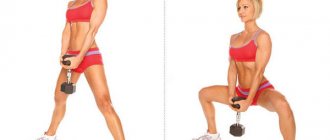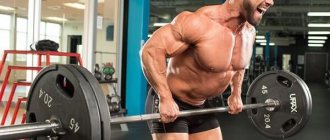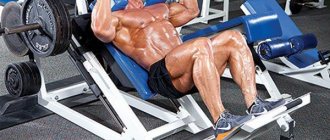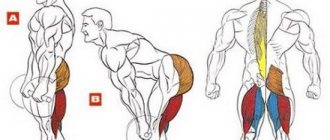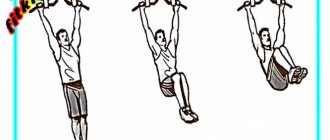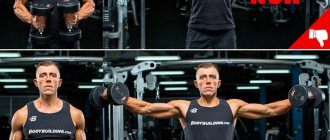Bulgarian lunges (Bulgarian squats) are a complicated variation of classic lunges, which are used by athletes to specifically work the leg muscles. By placing your foot on a bench or step, the load is concentrated in the muscles of the leg that is in front. The effect of such attacks is enormous, and let's take a closer look at why.
Specifics of Bulgarian lunges
Bulgarian-style lunges (otherwise known as split squats) are a tool for influencing the areas of the hips and buttocks, giving them a sculpted configuration. They have much in common with classic lunges, but are more complex due to the placement of the foot behind the bench (step).
In addition to creating a beautiful muscle definition in the lower body and a weight loss effect, such training is useful for people with an imbalance of strength in the legs (one is larger, stronger than the other). Practicing Bulgarian lunges helps overcome this problem by influencing the characteristics of physiological development.
As a result, the muscles of the other leg are subject to increased stress. Maintaining balance becomes more difficult. This exercise is otherwise called a one-leg squat. Maximum weight shift on one of the legs is the basis of the exercise.
Execution technique
This training complex is characterized by increased complexity, despite its apparent simplicity. Therefore, following the technical instructions is important.
A gymnastic bench, a step, pieces of furniture, and other options are used as support. The height is adjustable depending on your physical fitness and stage of training.
It is important to warm up your knee joints before starting the exercise. Most often, such squats are performed using dumbbells.
Rules for step-by-step implementation
- You should take the starting position (IP): standing straight, with your back turned to the support, dumbbells lowered along the body. One leg is bent at the knee back, thrown onto the bench, the other is stepped far forward, slightly bent at the knee, the back is straight.
- Bend your knee, lowering your hip (do a squat), exhale. Lower yourself until your thighs are parallel to the floor, keeping your body level.
- Having placed a powerful emphasis on the heel, push up, returning to IP, inhale.
- Repeat 10-20 times, performing 3-4 approaches with each leg. The load is added to the lagging leg.
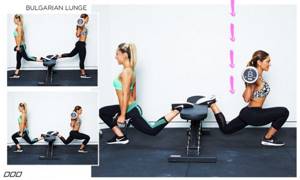
Technique for performing Bulgarian lunges
During the exercise, do not fully extend the knee. At the moment of squatting, it should not cross the border of the toe. In the absence of weights, it is more convenient to hold your hands in front of you, crossed, or put them on your belt.
Common mistakes
Bulgarian lunges are an effective exercise for shaping the shape of your legs. The technique of performing it has its own characteristics, which are associated with the need for careful coordination of movements and maintaining balance during squats.
Having studied the typical mistakes during lunges, you will be able to track them and hone the exercise technique to perfection. So, the main mistakes and ways to eliminate them.
| Errors | How to fix the error? |
| Distortion of posture during squats | Watch your back, keep your posture straight |
| The toe of the supporting leg is turned outward. | Turn the toe of the supporting leg inward |
| Step too short or too long | Calculate the optimal step length, which will prevent you from losing balance during a squat |
| Knee angle too sharp when lunging | When squatting, watch your knee |
| Do not complete squats | Squat until your supporting thigh is parallel to the floor (or lower) |
| Support your knee while coming out of a squat | Don't lock your knee while rising from a squat |
| Lean forward and move your knee forward during the exercise | Watch your knee, do not allow it to go beyond the plane of your toes. |
| Do jerk squats | Do the exercise slowly |
Initially, you need to develop the correct technique for performing the exercise and learn how to maintain balance while squatting. As you progress, you can begin to complicate the Bulgarian squats by using light weight dumbbells as weights. You can also choose a higher bench to make your squats as deep as possible. The optimal number of repetitions on one leg is 10-12 times. There are 3-4 approaches in a set.
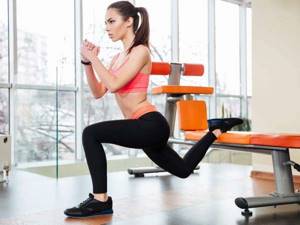
Bulgarian lunge variations
The essence of the technique is identical. The dosage of the load is important, taking into account the preparedness of the body. The skill of maintaining equilibrium (balance), which develops with the active work of a group of stabilizers, will be useful when performing other physical activities.
From a fitball
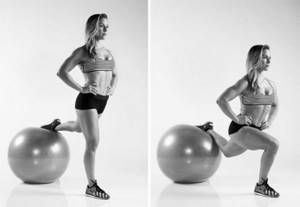
The basis is the use of an elastic ball instead of a hard support, which provides a soft fit, which makes the exercise easier.
With a barbell
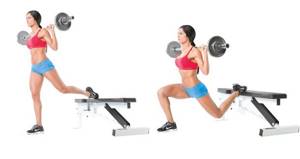
It is important to avoid excessive weight of the barbell
- The required weight of the barbell should be selected individually.
- Using an overhand grip, place the barbell on your shoulders;
- Stand up in the same way (with your back to the support, raising one leg on it), slightly move the pelvic area back to reduce the load on the spinal column;
- As you exhale, perform a squat until your thighs are parallel to the surface of the floor;
- As you inhale, while leaning on your heel, stand in the IP position.
On the Smith machine
The exercise machine allows you to reduce the load on the torso thanks to its fixation. The basics of the technique are the same:
- adjust the weight on the barbell, place it on the back muscles slightly below the shoulders, positioned in the machine;
- take a step forward with your foot, arching your back;
- Squat down gently as you exhale until the thigh of the working limb is parallel to the floor;
- while leaning on the heel, while inhaling, return to IP.
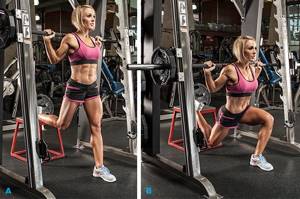
This option is considered the safest, since it is impossible to lose balance. This allows you to better concentrate on technology. If there is discomfort from the barbell, it is suggested to place a towel between it and the body.
Bulgarian type lunges compared to classic ones
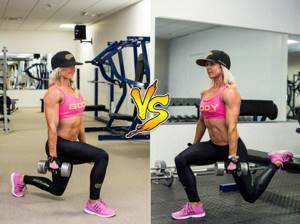
If in ordinary lunges the front leg accounts for 55-60% of the load, then in Bulgarian lunges it is 70, or even 80%
The exercises are multi-joint, which is similar to regular lunges. The same muscles are activated. But the entire load is performed on one leg. The other leg (supporting) serves to support and maintain balance.
Targeted training of individual muscle groups gives a good effect. With proper control, the load on each leg is targeted. It can be proportionally increased for the lagging leg. The lack of tilting of the body, unlike the classic version, reduces the load on the spinal column.
Benefits of using Bulgarian lunges:
- improving the balancing functions of the body;
- good conditions for isolating leg muscle groups;
- stimulation of volumes and strength of the lagging leg;
- activation of the development of optimal buttock shapes;
- improving joint stability (hip and knee);
- strengthening small muscles in the legs, core muscles, stabilizers;
- improving the ability to push and jump;
- variability and ease of use at home using a chair or sofa.
Bulgarian lunges are characterized by the suspended state of one of the legs, in contrast to the uniform use of both legs in the usual version. Putting weight on one leg makes the task more difficult. The quadriceps works without pause.
If you compare the exercise with regular squats using a barbell, then in the Bulgarian version the activity of the hamstrings and buttocks is significantly higher. With a barbell, the activity of the quadriceps increases. Testosterone levels rise identically in both cases. It is easier to maintain balance with dumbbells than with a barbell.
Split squats serve more for the formation of relief. Classic lunges are more suitable for increasing the total mass of leg muscles.
Working out with a barbell
What other types of squats are popular? The barbell squat became famous among athletes around the world thanks to Zercher (Canadian powerlifter). Zercher squats are universal; you don’t need any special conditions to do them. They can be easily done at home without using stands.
When doing Zercher squats, the apparatus is placed in the area between the chest and abdomen, filling it with optimally selected weight. The barbell is lifted with arms bent at the elbows. At the same time, the forearms are pressed to the chest, which ensures reliable fixation of the bar in this position. Having carried out the lifting, you can take the starting position (the person moves away from the stand a couple of steps with his feet wide).
Zercher squats are done slowly, the pelvis must be pulled back. The squat is done until the angle formed by the thigh and calf muscles becomes straight. When the manipulation is performed correctly, the knees merge with a straight line (formed by the feet). The torso intersects perpendicularly. Once in the indicated position, the person can exhale and stand up. Zercher squats perform a certain number of approaches, this is determined by the physical fitness of men or women.
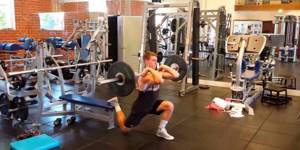
Zercher exercises are included in the complexes of programs for professional athletes. They clearly coordinate all processes and manipulations. A person will be able to become strong, learn endurance and good coordination.
The main muscle group pumped during squats is the quadriceps. Even during Zercher's manipulations, the calf muscles, buttocks, and thighs are involved. It is better to wrap the bar with some material, for example, a towel, which will help prevent the appearance of calluses on your hands.
In the process of manipulations according to the Zercher type, it is allowed to spread the feet to the sides. The back is flat, it can be slightly bent in the lumbar area. The athlete’s head does not drop; he needs to look forward. Zercher (Zercher) exercises require good physical preparation of the athlete. Since Zercher squats with a barbell are very difficult, if you have the slightest difficulty, you should seek help from your partners.
Practical tips and advice
Recommendations (technical) for the implementation of the proposed complex:
- perform movements at a slow pace;
- keep your back straight, don’t bend over, look forward and not down;
- maintain an average stride length, without shortening or lengthening;
- Keep the supporting thigh parallel to the floor when lunging;
- do not sharpen the angle of the knee, do not point your toes forward, do not block it when lifting;
- start lifting by pushing off with your heel;
- follow the principle “from simple to complex”: gradually increase the number of repetitions, the weight of dumbbells and the height of the bench.
At first, it is important to maintain balance and then increase the depth of the lunges. When performing lunges with dumbbells, the arm muscles are also given a workout.
If your knee extends beyond your toes when squatting, you should move your leg forward a little further. To achieve maximum results, do not fully extend your knee when lifting; this will increase muscle tension. When squatting, the lower leg must be supported vertically.
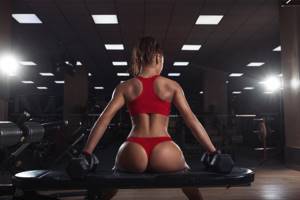
If you follow the technique and recommendations, the results will be noticeable after two weeks of systematic training. Moreover, the result can not only be assessed visually, but also physically felt. When implementing the program, the efforts that were evident at the beginning will no longer be needed.
Popular types
Jefferson squats are also popular. To begin with, the barbell is placed on the floor. The person must stand so that his feet are on opposite sides of the bar. Then you need to lean forward, bending your knees. The back must be straight. The bar is grasped with a neutral grip with one hand.
Then you need to take the equipment from behind with the other hand. The body is located strictly in the middle of the instrument. The distance from the body to the hands should be the same. Next, you need to straighten up, place your feet shoulder-width apart, perhaps stand with a relatively narrow stance, and turn your toes slightly to the sides.
The action is performed while inhaling, the thighs should be in a position parallel to the floor. During the process, you should not allow your knees to go beyond your feet. In the starting position, Jefferson squats push your feet off the floor. The equipment is held in outstretched arms, and the elbows are slightly bent.
Jefferson squats do not involve tension in the arms; the upper limbs only support the weight. The technique is aimed at performing actions thanks to the hips. For women who like to experiment, it is permissible to use straps on the wrists.
If you do not use additional loads, then sometimes squats are performed with abduction of one leg (they change alternately). There is a positive effect on the leg muscle complex. The number of approaches can be 5 times, since the technique is not particularly difficult.
A good type of exercise is Indian squats. In the starting position, the legs are placed not wide, the toes are separated. When squatting, keep your back straight, thighs parallel to the floor, and heels off it. After this, you need to immediately push off with your toes and get up. Movement requires swiftness and high speed from a person. At this time, you need to raise your arms to take them to their original position. In order not to experience negative sensations and to be able to perform more repetitions, you need to remember about proper breathing.
Contraindications and precautions
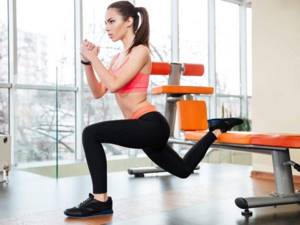
There are situations when it is necessary to completely eliminate the use of such attacks
If the rules of execution are violated or contraindications are ignored, Bulgarian lunges can cause harm. These squats, considered difficult, are recommended to be performed by people with training experience.
Precautionary measures
- Regulation of the weight of the burden is important. If you have muscle weakness or hand injuries, the complex should be performed without additional weight. If your balance is unstable, you should also stop using dumbbells.
- Beginners are not advised to rush to include this exercise in their training because of the complexity of its implementation.
- It is imperative to monitor the position of your back. It should remain level.
- To avoid injuries, training, like any other, must begin with warming up the joints and muscle corset.
Contraindications:
- pathologies of the knee joints (they experience enormous stress);
- diseases of the spine in which axial loads are prohibited;
- heart disease, blood vessels: (for example, hypertension);
- neurological abnormalities.
Bulgarian lunges are considered more effective compared to the classic version. Dosed disproportionate load on the legs, training the balance of the torso, improving joint flexibility, the ideal shape of the legs and buttocks - all this is achievable when using Bulgarian lunges in training complexes.


